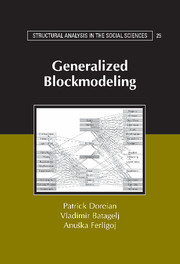Book contents
- Frontmatter
- Contents
- Preface
- 1 Social Networks and Blockmodels
- 2 Network Data Sets
- 3 Mathematical Prelude
- 4 Relations and Graphs for Network Analysis
- 5 Clustering Approaches
- 6 Optimizational Approach to Conventional Blockmodeling
- 7 Foundations for Generalized Blockmodeling
- 8 Blockmodeling Two-Mode Network Data
- 9 Semirings and Lattices
- 10 Balance Theory and Blockmodeling Signed Networks
- 11 Symmetric–Acyclic Blockmodels
- 12 Extending Generalized Blockmodeling
- Bibliography
- Author Index
- Subject Index
- Titles in the series
12 - Extending Generalized Blockmodeling
Published online by Cambridge University Press: 13 January 2010
- Frontmatter
- Contents
- Preface
- 1 Social Networks and Blockmodels
- 2 Network Data Sets
- 3 Mathematical Prelude
- 4 Relations and Graphs for Network Analysis
- 5 Clustering Approaches
- 6 Optimizational Approach to Conventional Blockmodeling
- 7 Foundations for Generalized Blockmodeling
- 8 Blockmodeling Two-Mode Network Data
- 9 Semirings and Lattices
- 10 Balance Theory and Blockmodeling Signed Networks
- 11 Symmetric–Acyclic Blockmodels
- 12 Extending Generalized Blockmodeling
- Bibliography
- Author Index
- Subject Index
- Titles in the series
Summary
In our concluding chapter, we step back from the details of specific analyses and examine the overall framework within which these analyses were conducted. In Chapter 6, we distinguished conventional and generalized blockmodeling and stressed fundamental differences between the two approaches. Chapters 6–11 contain a variety of blockmodels fitted with the generalized blockmodeling framework. Here, we pursue some of the implications stemming from the use of generalized blockmodeling methods.
BLOCK TYPES
One key feature in the development of generalized blockmodeling is the translation of equivalence ideas into a corresponding set of ideal block types. For structural equivalence, the two ideal block types are null and complete. For regular equivalence we added the regular (one-covered) block type. Empirically, rather than focus on types of equivalence per se, we focused on the block types. This has the benefit, realized in the materials in Chapters 6–11, of permitting a potentially unending way of generalizing blockmodels and motivates the title for this book. Once we are free to specify additional block types, we are freed from having to conform to one or two particular definitions of equivalence. As a result, we are able to specify new types of blockmodels based on the new block types. The expansion of block types and blockmodel types can proceed both on substantive and technical foundations.
In the initial presentation of new block types in Chapter 7, row-regular blocks and column-regular blocks are natural generalizations of regular blocks that were useful block types for the TI example and the baboon grooming network. The row-function and column-function blocks were blocks that were specified more on technical grounds.
- Type
- Chapter
- Information
- Generalized Blockmodeling , pp. 347 - 362Publisher: Cambridge University PressPrint publication year: 2004
- 2
- Cited by



